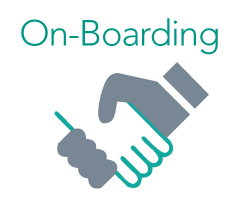On-Boarding: A Requirement for a Variety of Reasons
Ten years ago the term “on-boarding” was not even a common corporate expression. Today it is gaining acceptance as a common part of “HR vocabulary,” but it should be a mutually understood term by employees and HR representatives. More importantly, it should be embraced by top management, especially for executive, management, and professional level positions.
But what is on-boarding? It is simply a process to assist the transition of new employees into an organization. Below we will share more details about on-boarding, including the objectives, the primary orientation activities, and how to use orientation to create a great “first impression”.
The Objectives of On-Boarding

The objective of the process may vary somewhat by company. For professionals, managers and executives the objectives are typically to:
- Help make new employees feel welcome
- Accelerate a new employee’s contribution and productivity
- Reduce the risk of turnover of the new employee
- Improve customer or client satisfaction
- Align the new person’s role to both short and long term needs of the company
Primary Orientation Activities
Most companies have good orientation programs. A solid orientation program is one part of a comprehensive on-boarding plan. The primary activities are to:
- Review and enrollment in employee benefit programs
- Train on phone and email systems
- Workspace orientation
- Provide needed supplies, tools, computers, phone, etc.
- Introduction to management and employees this person will be working with
Creating the “First Impression”
Most companies have good orientation programs. A solid orientation program is one part of a comprehensive on- boarding plan. The primary activities are to:
- Consideration of personnel who welcome the new hire at the door
- Work site orientation: tour of facilities, introduction to colleagues, executives, team members, departments, break room site, etc.
- Work place preparation: work area (cubicle or office), phone, computer, email, tools and supplies to do the job
- In-depth orientation to the company’s mission, vision, values, and history
- Explanation and enrollment into company benefits programs